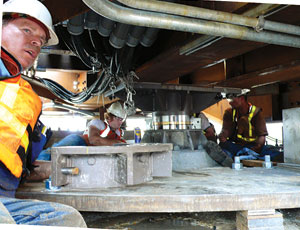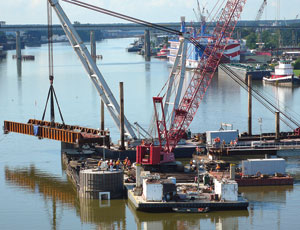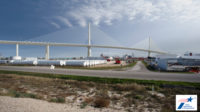The 1905 shaft-driven Burlington Northern Santa Fe Railway swing bridge over Bayou Boeuf near Morgan City, La., has begun a new life after an intensive four-day project that converted it into a computerized, hydraulically operated crossing with opening times cut from 17 minutes to seven.


During a 96-hour window that ended at midnight on Sept. 24, OCCI Inc., Fulton, Mo., replaced the bridge’s 240-ton, riveted, steel-plate, swing-girder span with a 200-ton, welded plate girder. “This is the most intense-schedule project I’ve worked on in 25 years,” says Ted Kettlewell, OCCI executive vice president. “When working a rail project, there is no such thing as not finishing on time, unless you don’t want to get any more work.”
BNSF has planned the project for several years, says John Christensen, BNSF manager of structures, but it became pressing after the bridge took some “hard hits,” including a barge collision in 2005 during Hurricane Rita that knocked it 11 ft off center. OCCI’s $19.5-million contract included construction of concrete cells to repulse vessel strikes.
In February, OCCI began driving pilings through the deck between existing piers to add support for 40-ft-long spans that would replace 80-ft ones. The work was done under live track conditions during six-hour windows.
OCCI changed out the east and west approach spans in 12-hour windows on Sept. 17 and Sept. 19. Lifts were made using a 175-ft barge with a 500-ton derrick and four continuous nylon slings, each rated at 180,000 lb. OCCI’s fabrication division, Missouri Fabricators, built the swing section and a 30-in.-dia center pivot assembly in Jefferson, Mo. Everything was “prebuilt, prewired, prepackaged and delivered in one piece because we knew we wouldn’t have time to do any of that out here,” Kettlewell says.
Mike Monnig, OCCI field engineer, operator and superintendent, orchestrated the lifts. “Trying to get this big apparatus moved in by boat with very little tolerance is a challenge,” Monnig says. “An A-frame doesn’t pivot,” he adds, so it was winched into alignment with the rail.
The new span had to be “perfectly balanced” to place on the center pivot, Kettlewell says. Monnig set it within 1⁄8-in. and held it in balance until a crew could crawl under and install a collar to more closely align it on the center pivot. Once the new span was in place, OCCI installed grout under wedge base plates, leveled the tread plate and aligned the track to the proper elevation.
Koontz Electric, Morrilton, Ark., had about six hours to tie in all electrical and signaling to the new control house and computer center at the east end of the bridge. The bridge was opened to navigation on September 30.


Post a comment to this article
Report Abusive Comment